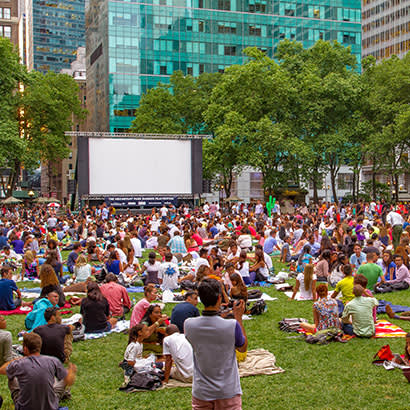
A measure of success for park and recreation professionals is in getting more and more people outside, enjoying the benefits of parks. And, whether that is walking or jogging on a trail, attending an event in a park or simply lounging on a bench or lawn, more and more people are venturing outdoors to do some nature bathing.
With this increase in outdoor use comes an increase in the impact that use can have on the landscape. Up until a few years ago, one had to look no further than the nation’s “front yard” — the National Mall in Washington, D.C. — to see the impact long-term high use can have on a site. The Mall, which is traipsed on by roughly 30,000 people a day, underwent a major overhaul starting in 2015 to remediate the damage done to the turf. Fencing was installed around many of the grass squares to protect them from foot traffic, much to the dismay of those who just wanted to enjoy a pick-up game of frisbee golf or to lounge on the grass.
Most parks don’t endure the level of wear and tear on the Mall. However, as more and more parks rely on large-scale events, such as music festivals, fairs and other community events to generate income, managing the impact these events can have on the landscape is critical to its sustainability. The impact of heavy use may have many forms and a variety of effects on the landscape. However, one of the most significant impacts is soil compaction on lawns. Healthy soil that is well-drained, properly aerated and has balanced nutrients and a healthy soil biology can support healthy grass, plants and trees. Heavily used landscapes are damaged in many ways; for example, visitors snapping limbs off trees or picking flowers from or trampling on young seedlings in a garden bed. Compaction on lawns is one of the major impacts of heavy usage and one of the hardest to address. When that soil becomes compacted because of heavy use and/or nutritionally imbalanced, it can no longer support healthy growth or recover from repea
ted heavy use.
Wear and tear is inevitable however, so according to Ronnit Bendavid-Val, director of gardens and grounds at the Brooklyn Botanic Garden (BBG), “A more realistic goal is to reduce its impact.” In “Managing ‘Wear and Tear’ in Heavy-use Landscapes,” published by the Ecological Landscape Alliance, Bendavid-Val divides the contributors to wear and tear into two categories: physical impacts that have a direct physical effect on the landscape and come from outside the institution, organization or agency that manages the park/garden, and organizational practices rooted within the institution, organization or agency. She provides some examples of these contributors:
“Physical Impacts:
- High number of daily visitors or event attendance (expressed primarily as foot traffic, with some additional impacts)
- Specific human interaction with the landscape (e.g., carved graffiti in trees)
- Design & construction [for example, construction crews disregarding tree protection zones or designing a space where debris or garbage needs to be removed without vehicle access]
Organizational Practices:
- Institutional priorities
- Lack of understanding of horticultural needs by administrative staff
- Staff habits (horticulture/operations staff)
- Budget as it affects staff numbers and equipment”
Managing the Wear and Tear
An annual turf renovation plan is important for any heavy-use lawn. Such a renovation would include, for example, aeration, over-seeding and top-dressing. In addition, prior to an event, it may be desirable to take extra precautions to protect the lawn, such as by roping off certain areas. Following an event, and depending on the time of year, it’s important to act to remediate the impact of the event itself with, for example, some form of aeration and additional over-seeding and top-dressing, to name a few.
Other ways to lessen physical impacts include educational signage that explains why an area is being roped off or fenced in instead of simply ordering patrons to “Keep off the grass,” using compaction mats to provide temporary turf protection — for the 2017 inauguration, it’s estimated that 50,000 panels, each 16 feet square, were used to protect the turf on the Mall — hiring security guards to monitor the public’s access to certain areas (a more expensive but effective method), rotating field use and/or closing fields following heavy rains and engaging the community to help protect the landscape (this approach must be carefully crafted so as not to hinder park operation).
Above all, education of an organization’s non-horticultural staff and the public about landscape needs is a critical component in lessening heavy-use impacts. This can range from in-depth periodic workshops by horticulture experts to staff and the public on various landscape-related topics, to something as simple as informational signage and consistent messaging across an agency’s communication platforms.
The revenue generated from hosting more outdoor events can help a park provide the funds necessary to hire additional staff and equipment for landscape care. However, a delicate balance must be struck between the park’s event management staff and staff responsible for maintaining a healthy landscape. Together, these departments should create a policy for scheduling events that builds in recovery time for high-use green spaces, whether that means rotating the area being used or closing an area following a heavy rain or at certain times of the year so as not to cause further damage to the landscape.
As more and more people heed the call to get out and enjoy the outdoors, and more park and recreation agencies rely on this revenue stream to enhance their budgets, managing the impact of wear and tear on their green spaces from increased usage will be important to their sustainability.
Sonia Myrick is the Executive Editor of Parks & Recreation magazine.

